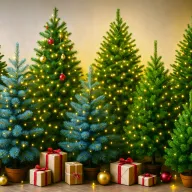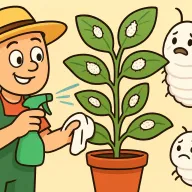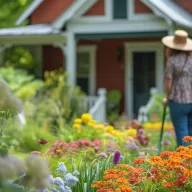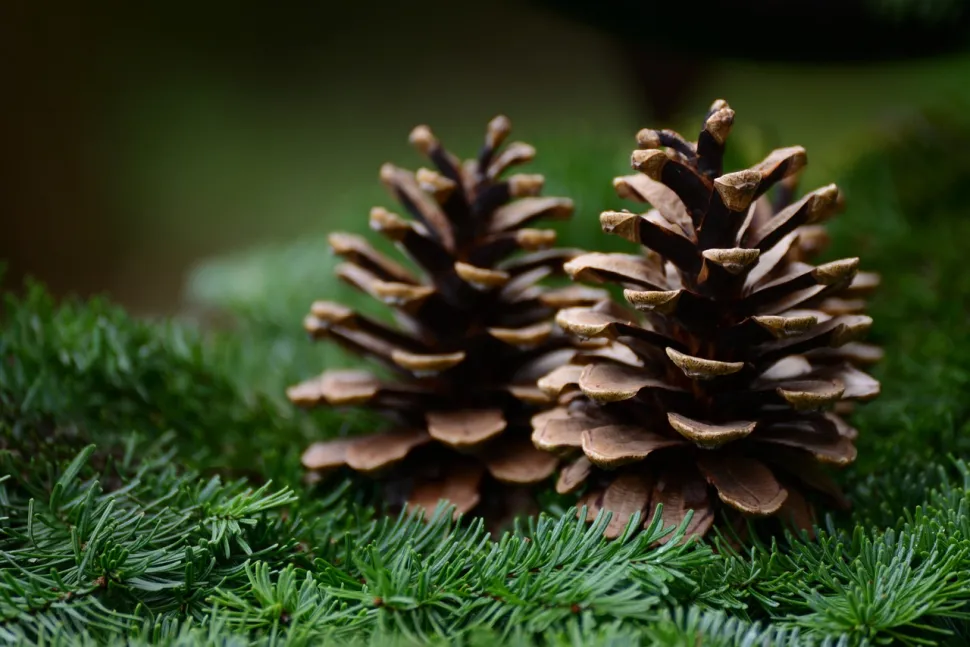
Potted Christmas tree: our tips for replanting in the garden after the holidays
Article for :All parent plants
There's nothing sadder than a plucked Christmas tree stranded on a sidewalk after the holidays... You'd like to prevent your beloved tree from ending up in compost and you've decided to replant it in your garden? Here's what you need to do to ensure your tree enjoys a golden retirement.
Which Christmas tree to replant?
Bushy habit, symmetry, needle color... These are the first criteria on the list when choosing your Christmas tree. But if you're planning to give it a second life in the fresh air once the presents have been unwrapped, you'll need to add a few more!
Buy a potted or rootball tree

Which of these trees has no chance of surviving after Christmas?
There are several types of natural Christmas tree on the market:
- Cut trees ;
- Trees in pots or containers;
- Root ball trees.
These trees are grown in the ground and then harvested, along with their rootballs, from the ground. They are then removed, along with their soil and roots, and potted. As they retain their root system, they won't have too much trouble surviving in your garden. They are sold in nurseries and sometimes in garden centers.
If you can't find a clump of rootballs, turn to potted trees. But be careful! Not all conifers sold in pots, with roots surrounded by soil, can be replanted after Christmas. You need to choose a tree grown directly in its pot. These are sold in garden centers with the container in which they were grown, or after repotting.
But there are also fake container-grown trees. These trees cannot be replanted. If they are grown in the ground, they are ripped out and sold without their entire root system. The roots are generally insufficient for the plant to resume growth, and it eventually dies. False container trees are sold in pots filled with potting soil. It's easy to mistake them for a potted tree. It's best to ask the seller for information to make sure you're not mistaken.
Finally, fir trees cut off at the trunk aredestined to be composted after the holidays. They don't have roots and won't be able to grow new ones. While some species, such as willow and poplar, can take root from scratch, this is not the case for conifers belonging to the Abies, Picea or Pseudotsuga genera.
Choose the right variety for your garden
Take into account the plant's needs. The variety must be adapted to :
- Climate (hardiness zone, humidity);
- Environment (exposure, resistance to pollution and sea spray);
- Soil type (humus, sand, limestone, etc.).
Don't forget to consult the growing guide for the variety you're interested in on the Monstera app! You'll find all the information you need to make the right decision.
You should also think aboutthe growth and development ofyour tree. At the moment, your potted tree is the ideal size for your townhouse garden. But norway spruce (Picea abies var. Abies) grows rapidly and reaches 40 meters in height. Nordmann Nordmann fir (Abies nordmanniana) is slower-growing, but easily exceeds ten meters in height! You don't live in a mansion surrounded by a forest? Turn to more compact varieties and dwarf hybrids such as :
- abies koreana (Abies koreana) 'Compact Dwarf', 'Silvershow' or 'Icebreaker';
- Nordmann fir 'Golden Spreader', 'Münsterland' or 'Barabits Compact';
- Little Gem', 'Acrocona' or 'Tompa' spruce.
Select a healthy tree
Once you've made your choice, check that the tree is in good health. Its needles should be dark and not fall off when you shake it. Also check the condition of the branches and foliage inside. Your tree should be green. Brown or yellow is often the sign of a current or past mite attack. These diseased specimens will find it harder to withstand the warmth of your living room and the outdoors.
A final tip when choosing your tree: opt for a young tree. It will adapt more easily to change!
How to care for your natural potted tree over the festive season?
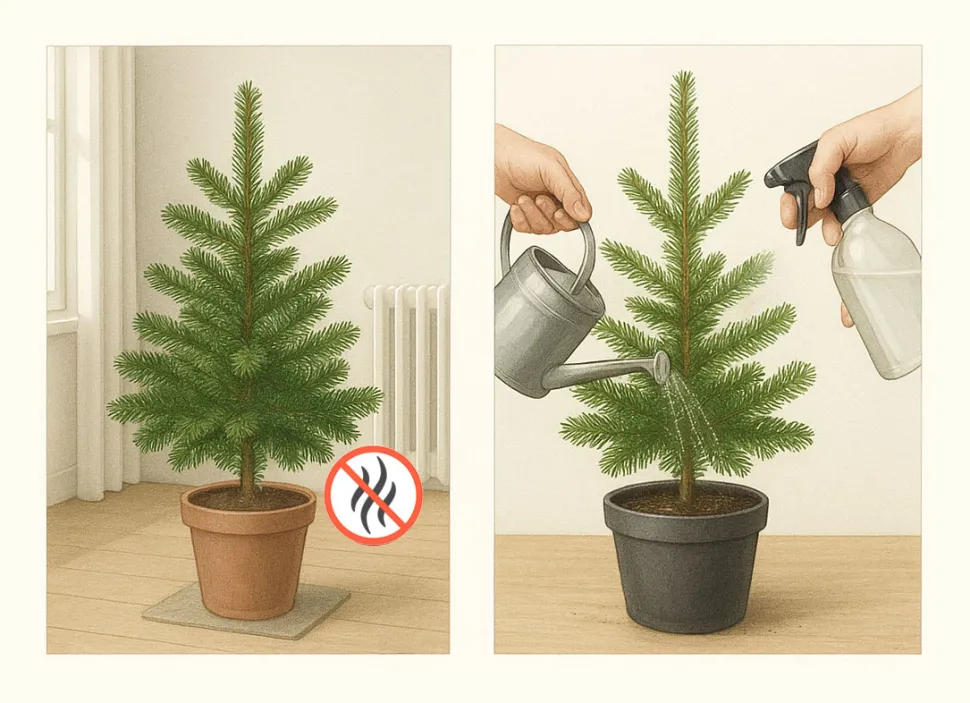
The secret to your tree's survival indoors? Humidity and no heat
Conifers are not houseplants. They're hardy plants, made for the great outdoors, snow and even altitude. They don't take kindly to winter heat, especially when it's as dry as it is in our homes. So the best place to put your Christmas tree is outside, on your terrace, in your garden or in an unheated room like your veranda or loggia.
But since we're sure you don't want your favorite garlands stolen or your presents opened outside on the morning of the 25th, here are a few tips on how to care for your indoor tree.
1.don't place your tree next to a heat source (fireplace, radiator, oven...);
2. Water copiously when the substrate dries on the surface, i.e. At least once a week;
3.mist the foliage with non-calcareous water and place a bowl of water at the foot of the tree to increase ambient humidity;
4.keep your tree indoors for as short a time as possible (ideally one week).
Shake your tree tocheck that it's healthy and ready to be planted. If the needles remain in place, you can replant it. If they fall off, the tree has suffered too much and can't be replanted.
Has your tree passed the test? Gradually get it used to the outdoors. For example, you can leave it in your garage for a few days (provided there's light) to acclimatize to winter temperatures.
How to plant your Christmas tree after the holidays?
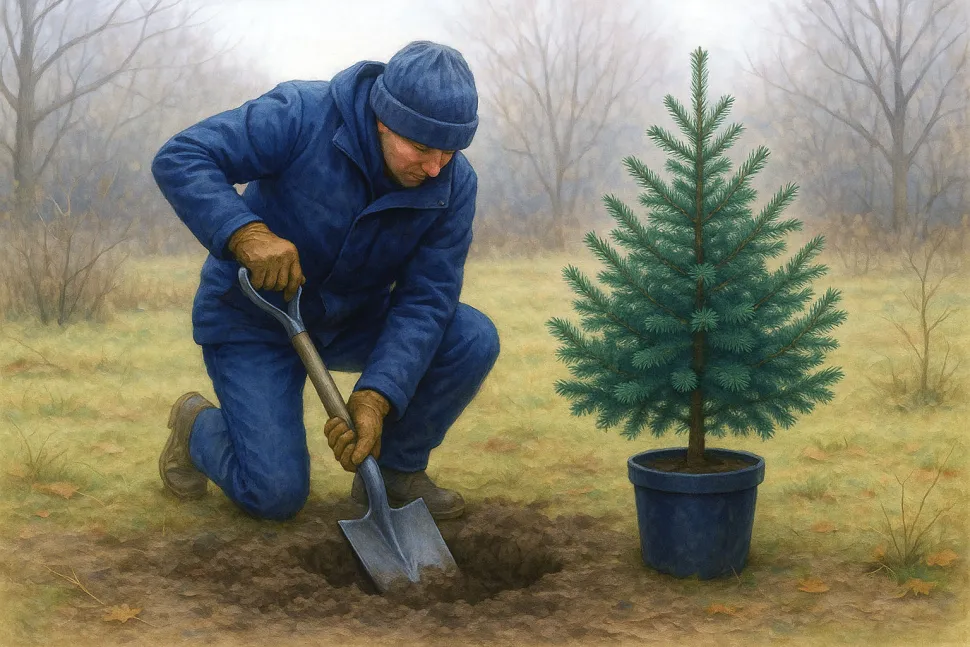
You can plant your tree at any time if the ground is not frozen.
At Monstera, we usually recommend planting your conifers in autumn. However, your Christmas tree won't be able to wait that long. Its pot is probably too small and its potting soil too poor to hold out until then. Plant it as soon as possible, even if it's cold or snowing.
Planting is the same as for any other shrub. Water generously or soak the tree to rehydrate it. Then dig a hole at least twice as big as the root ball. Plant your conifer, making sure the rootball is level with the ground. Then backfill with your garden soil. If the soil is not quite suited to the needs of the species you've chosen, add compost, sand or potting soil to amend it. Remember to create a watering trough to facilitate maintenance and save water!
If the ground is frozen and you can't dig, don't bother. We advise you to leave your tree outside and, if necessary, repot it in a larger pierced pot. Use good-quality potting soil suited to the plant's needs. The following autumn, you can transplant it into the ground.
Should I keep the netting around the root ball when planting?
When you buy a fir tree, or even a houseplant, it's common practice to wrap a net around the root ball. Called tontine by professionals, this device is safe for plants. It helps keep the soil compact and simplifies transportation.
If the net is made of plastic or another material that will not disappear after planting (e.g. Wire mesh), you must remove it.
On the other hand, if the net is made of a biodegradable material (jute or cotton), you can keep it. However, remember to open the net at the top to avoid deforming the trunk when the tree starts growing again. We recommend that you leave the protection in place if the rootball is crumbly and likely to disintegrate during planting. If it is compact, don't hesitate to remove the wrapping.
Can I reuse my natural tree from one year to the next?

A potted tree can be brought in every year to play Christmas tree.
It all depends. If you've repotted your tree andinstalled it on your terrace, you can put it back in its pot for a few days to become your Christmas tree. Make sure you water it well so that the heat doesn't damage it too much.
If your tree is in the ground, it may not stand up well to being dug up and replanted every year. Conifers have a shallow but extensive root system. Pulling them out can cause damage to trees that are only a few years old. Some gardeners have taken the risk for a year or two, but it's best not to repeat the operation after that. Your plant won't survive. As with a potted tree, pay particular attention to its upkeep during its stay in your home.
If you want to reuse the same tree every year, why not adopt an Araucaria heterophylla? Araucaria heterophylla (Araucaria heterophylla) is one of the few conifers that can be grown indoors. Its conical habit, symmetrical spire and light-green needles make it the ideal support for your decorations.
By Servane Nemetz
on 09-11-2025 at 09h54
on 09-11-2025 at 09h54
